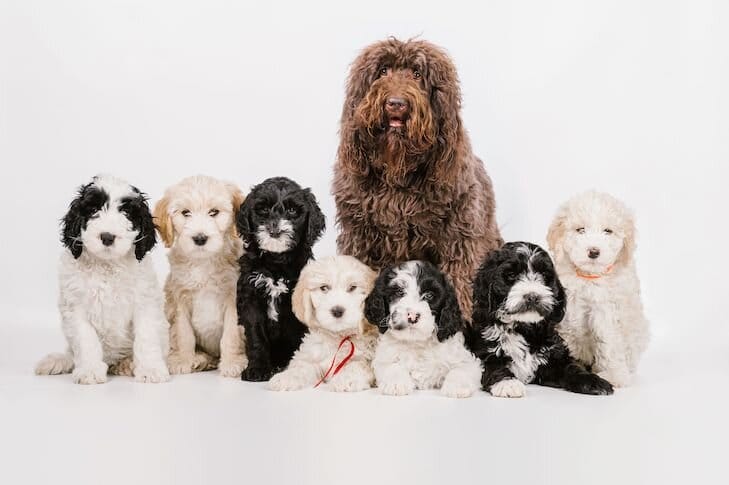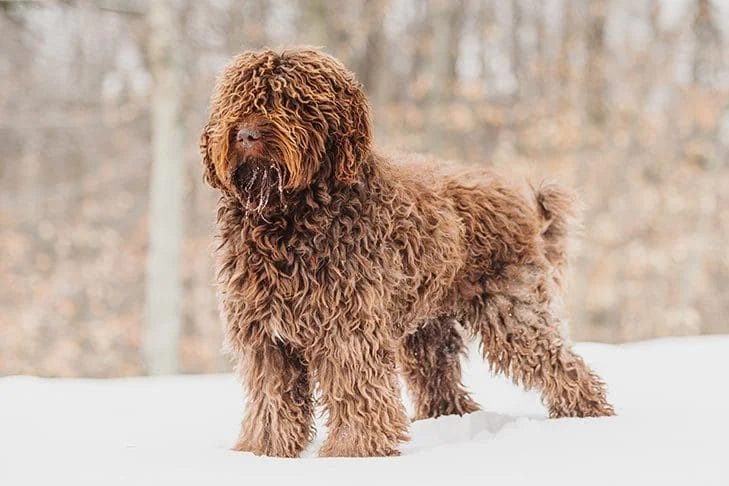The Barbet is an archetypal water dog of France, a rustic breed of medium size and balanced proportions that appears in artwork as early as the 16th century. The Barbet is slightly rectangular in shape, with a large head and a long, sweeping tail. He has long, dense curls on his head and a striking beard. The Barbet, an agile athlete, has mostly been employed to locate, flush, and retrieve birds. He has a positive attitude and is very gregarious and loyal.
The rich curly coat that covers this rustic, medium-sized bird dog from the top of his wide, broad head to the tip of his curved tail is his distinguishing feature. The coat comes in black, gray, brown, or fawn colors, with white markings on occasion. The Barbet’s charmingly shaggy coat and friendly demeanor give the appearance of a Muppet come to life, but it is a robust, solidly built dog that has been bred for ages to be a sharp hunter and tireless swimmer. They are extremely bright and quickly pick up new skills. They have a peaceful demeanor and are pleasant to live with as long as their activity requirements are met.

Barbet Dog Breed: Characteristics, Origin & Top 3 Care Guide
About Barbet
Weight 37-62 lb
Lifespan 13-15 years
Group AKC Foundation Stock Service
Best Suited For seniors, families with children, singles, houses with yards, hunters
Temperament friendly, loyal, intelligent, fun-loving
Comparable Breeds Poodle, Briard
Height 22.5-25 inches
Barbet Basics
The Barbet is a medium-sized French water dog with a rich curly coat. Despite being an uncommon breed, seeing one of these canines is a sight to behold. They are strong and proud, but they can also be seen playing in the dirt. The Barbet is a cheerful and fun-loving breed that would make an excellent choice for a new family pet.
The Barbet is a medium-sized French water dog breed notable for its rich curly coat.
Origin
Though this breed is still quite rare in the United States, it has been around for a long time. This dog breed gets its name from the French word for beard, “barbe.” Throughout its history, it has been utilized as both a companion pet and a working breed, and this is still the case today.
Though the breed’s exact origins are uncertain, the Barbet is regarded to be the common ancestor of many current water dogs, including the Poodle, Portuguese Water Dog, and American Water Spaniel.
In truth, the names Barbet and Poodle were used for the same dog in France and Germany for hundreds of years. The breed’s popularity is increasing in the United States, although its current estimated numbers are still between 150 and 200.
Pedigree
The Barbet is a very old breed, with the oldest mentions dating back to 1387. This breed is supposed to be the ancestor of current water dogs such as the Poodle.
Food/Diet
Because the Barbet dog is a medium-sized breed, it is preferable to feed it a large-breed dog food mix. If you intend to utilize your dog for hunting or agility, make sure to feed him a dog food developed for active dogs to provide him the energy he requires.
The Barbet is a breed that is both intelligent and trainable.
Training
The Barbet is a breed that is both intelligent and trainable. Unlike several intelligent dogs, this breed is not generally domineering or headstrong. It is a wonderful hunting companion for retrieving ducks, thanks to his thick coat and webbed feet. This breed is also gifted in agility training, having placed first in agility competitions in France.
Even if you do not intend to hunt or show your Barbet, training is essential. Take your dog for a lengthy daily walk and provide him with plenty of fun and outside time. Socialization is vital, especially when the dog is young, to ensure that he remains friendly towards strangers and other dogs.

Weight
Temperament/Behavior
The Barbet is a pleasant and fun-loving dog that is intelligent and attentive. Though you may be tempted to give in to your puppy’s every whim, it is critical to begin obedience training at a young age.
Because of its companionability, this breed is ideal for seniors and families with children. These dogs form strong bonds with their owners and prefer to be kept up to date on family events at all times.
The Barbet, which was bred for hunting, has an active and sharp mind that requires continuous exercise. You should involve your dog in consistent training and play a lot of games to keep your dog from acquiring bad behaviors. Consider one of these hobbies for your dog if the breed does well in obedience and agility training.
Common Health Problems
Because the Barbet breed is so uncommon, little is known about the long-term health difficulties that this type of dog is prone to.
Ear infections, hernias, epilepsy, and hip dysplasia are among the most prevalent health issues encountered in this breed. Ear infections in particular are quite simple to avoid by keeping the ears clean and dry. Hip dysplasia cases can be reduced by proper breeding techniques.
Life Expectancy
The average lifespan for the Barbet breed is 13 to 15 years.
Exercise Requirements
The Barbet breed was bred to labor, thus they will be unhappy if kept caged up indoors all day. To stay fit, it need daily exercise and time to stretch his legs. Consistent training for your Barbet will prevent him from developing problem behaviors such as excessive chewing or barking.
The Barbet is a pleasant and fun-loving dog that is intelligent and attentive.
AKC
The Barbet can be registered with the ARBA or the UKC, but the AKC has not yet officially recognized it. The breed is now in the Foundation Stock Service Program; once the number of registered in the United States reaches 150, the AKC will formally accept the breed.
Coat
The Barbet breed’s biggest distinguishing trait is its long, woolly coat. It coats can be wavy or color, with acceptable hues including solid black, brown, fawn, gray, and white.
The thick coating of the dog’s hair protects it in cold water and also means that the breed sheds very little – shed fur gets matted into the coat rather than falling off the dog. As a result, regular brushing and grooming are required to keep the coat from matting too much.
Puppies
Barbet puppies are simply fluffy bundles of love who can’t wait to hug and play. These dogs have been known to have a silly side, preferring to sit calmly next to their owner as they do to play in the dirt. Puppy socialization is also necessary to ensure that they get along with other dogs as adults.

More information about Dog Breeds & Dog Care follow Dog Care Tips site.

